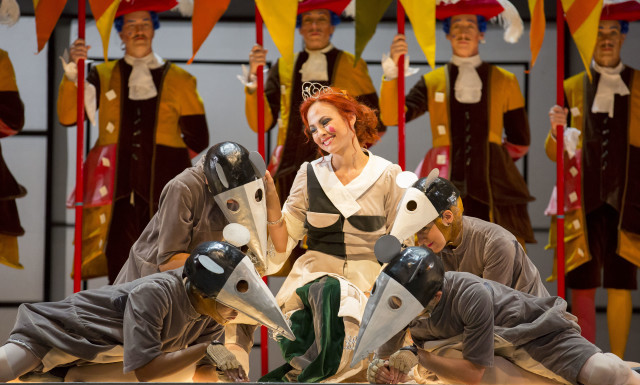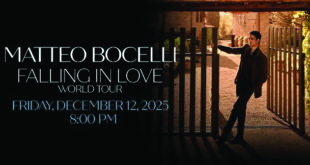
Going back many years, it is hard to remember a Lyric Opera production that fired on all cylinders so marvelously as on the October 23rd performance of “Cinderella.” (No doubt for marketing purposes Lyric calls Rossini’s comic opera “Cinderella” instead of its original, commonly known title, “La cenerentola.”) During the time I have been reporting on the many productions of operas at Lyric, I have never shied away from pointing out (and occasionally discussing “ad nauseum”) various weaknesses in the musical or dramatic presentations, but in this “Cinderella” I was extremely pleased to find only hearty strengths in every aspect of performance.
Top credit for this artistic bonanza must go to the company’s musical director and the opera’s conductor, Sir Andrew Davis, who kept the singers and musicians in perfect sync and the energy level high throughout the rather long piece. Davis’ and the Lyric orchestra’s version of the familiar prelude could easily be included in the Rossini overture collection of the most astute audiophile.
Kudos also to stage director Joan Font, and set and costume designer Joan Guillén. These two Spanish gentlemen created a production filled with well-justified movements coordinated with bright, delicious color. One of the funniest and most clever devices used (I assume it was a collaborative decision between the two men) was to employ and costume six actors to act and look like mice. Although this is indeed a comic opera, it’s still in Italian, and if the lines of dialogue didn’t get to the audience, the antics of the “mice” sure did.
Now for the music and singing. When you begin to hear a Rossini opera there are two things that strike you. Initially the music sounds a lot like Mozart, who composed some thirty years before Rossini began to make a name for himself. Well, this is no accident. Rossini deeply admired “Das Wunderkind” and he was not called “Il tedeschino” (“the little German”) for nothing. Very quickly, however, to an educated ear, it is apparent that the music is definitely not Mozart, and it has an individual style of its own — like the liberal use of the famous “Rossini crescendo,” which we hear both in the opera and its overture.
Next, your ear is so pleased by the opera’s melodies, you wonder why more Rossini operas (or other Bel Canto works) other than “Il barbiere di Siviglia” are not performed more often. But again, in very short order you realize that in order to put across a decent Rossini performance, virtually every singer in the cast must be a master of the coloratura — men and women. This means that each performer has to continually sing passages consisting of many pitches delivered with blazing speed. And each pitch must be well defined relative to the one before and after it. No room for any chromatic dung in Rossini!
Fortunately, the Lyric Opera cast of “Cinderella” was up to the task. Call him a Mozart tenor, a Bel Canto tenor, a Baroque tenor or a Rossini tenor, but in my book the absolutely best performer out of an entire cast of fine singers was Lawrence Brownlee, as the Prince. In solo and ensemble he was perfect, and never faltered in the devilishly difficult coloratura passages. You can tell how starved audiences are for bold, robust-sounding tenors, because whenever Mr. Brownlee gave us a taste of his powerful, ringing high notes, the crowd went wild. He’s a young man, and whether he’ll ever be a Manrico or a Cavaradossi is yet unknown. But time itself can bring more power to a voice. We’ll see.
Lyric’s Cinderella, mezzo Isabel Leonard, began just a tad weak vocally, but grew stronger as the performance progressed. This actually made some dramatic sense, as the Cinderella character starts out in the ashes and finishes as a princess. Yet as brilliantly as she sang the bravura rondo, “Non più mesta,” in the finale, it’s still hard to believe that Rossini wished her opening music to an old folk tune, “Una volta c’era un Re,” to be sung so softly or so half-heartedly.
Bass Alessandro Corbelli, the Don Magnifico, is an interesting case. In a way he reminds me of Tito Gobbi in that he doesn’t have the greatest instrument anyone’s ever heard, but he is always totally dedicated to his character and he is very musical to boot. I confess to being a little let down by his initial aria, “Miei rampolli.” I’ve heard other buffo basses sing it more powerfully. But as I got deeper into this fine production I came to appreciate Corbelli’s performance more and more. He had absolutely no problems with the coloratura, and supplied an easily-heard bottom to the ensemble harmonies.
The Dandini, baritone Vito Priante, was outstanding. Excellently made up to dupe the Magnificos, when he sang his “Come un ape ne’ giorni d’aprile,” he laid it on thick, at the same time entertaining the audience and justifying the Prince’s impression that he was overdoing things a bit.
A favorite of both mine and the audience was bass Christian van Horn as Alidoro. First of all van Horn has a tremendous bass voice that sounded beautifully in everything he sang. Getting back to the stage direction, I have seen a number of “Cenerentolas” where the director doesn’t seem quite sure what to do with Alidoro, especially for his solo “Vasto teatro é il mondo.” It may not be the most interesting music ever composed but it is a vital part of this opera and Sr. Font wove the scene into the drama in a way to keep the audience’s attention steady.
Providing most of the comic appeal and an extremely solid musical topside to the ensembles were sopranos Diana Newman and Annie Rosen as the “evil step-sisters,” Clorinda and Tisbe respectively.
For more, visit https://www.lyricopera.org.
 Fra Noi Embrace Your Inner Italian
Fra Noi Embrace Your Inner Italian





